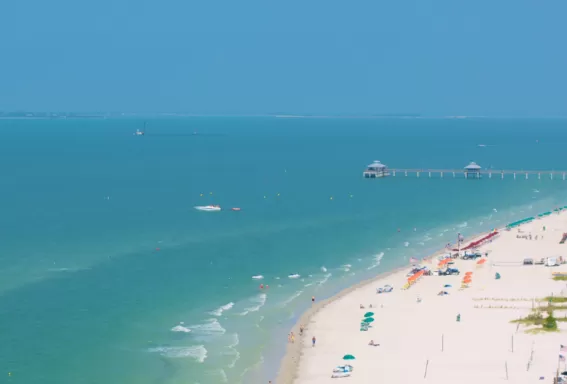Media Kit
Florida's Tropical Island Getaway
Unspoiled white sand beaches, exotic wildlife and lush subtropical foliage are the distinctive characteristics for which travel agents book their guests from around the world to The Beaches of Fort Myers & Sanibel. Known as Florida's "tropical island getaway," this charming paradise offers agents' active clients an abundance of golf, tennis and watersports as well as some unusual attractions.
Located in Lee County on southwest Florida's coast, the area embraces nine distinct sections, each with its own unique character. Best known are Sanibel and Captiva islands, connected to the mainland by an alluring three-mile-long causeway and to each other by a "blink-and-you'll-miss-it" bridge at Blind Pass.
Sanibel is known worldwide for its shelling. More than 400 varieties of shells can be found littering the beaches, particularly after an especially high or low tide. The main thoroughfare, Periwinkle Way, is Sunday-drive picturesque, lush with foliage and framed by a canopy of Australian pines.
On the way to Captiva Island, located toward Sanibel's northern tip, the J.N. "Ding" Darling National Wildlife Refuge is home to many exotic species of birds and plants. In all, the refuge occupies more than half the island. A four-mile drive with access to walking and canoe/kayak trails offers abundant opportunities for naturalists to see raccoons, alligators and long-legged wading birds. It was on Captiva that Anne Morrow Lindbergh, wife of the famous aviator, wrote her bestselling book, "A Gift from the Sea."
Traveling off the coast of Sanibel and Captiva islands, boaters marvel at the more than 100 outer coastal islands. Many are uninhabited mangrove clusters while others take visitors' breath away with their beautiful beaches. Both North Captiva and Cayo CostaIsland Preserve are known for their virtually deserted yet alluring coastlines and excellent shelling potential.
Cabbage Key, an island built atop an ancient Calusa Indian shell mound, is situated at mile-marker 60 on the Intracoastal Waterway. Mystery writer Mary Roberts Rinehart helped her son build his home here in 1938. The house is now a cozy inn with six guest rooms and a picturesque dining room papered in thousands of autographed dollar bills. The tradition, which has generated at least $70,000 worth of George Washington wallpaper, began when a thirsty fisherman left his bill taped to the wall, ensuring a cold drink the next time he stopped by.
Boca Grande is a charming turn-of-the-century harbor town on Gasparilla Island and another safe port for the rich and famous. Founded by the wealthy DuPont family in the late 1800s, this sleepy little southern town comes replete with small shops, cozy restaurants, waterside accommodations and beautiful beaches. The Boca Grande Tarpon Guides Association is available to provide all that is necessary for a successful tarpon fishing expedition.
Pine Island is a step back in time, when fishing reigned as the area's largest industry. Accessible by land via "the fishingest bridge in the USA" at Matlacha [Mat-la-chay], Pine Island's northernmost settlement of Bokeelia, provides the maritime stepping off point to the more remote out-islands.
Further south, Estero Island, home of Fort Myers Beach, long has been recognized as one of the "world's safest beaches" because of its gently sloping shoreline. The sand is particularly soft and white, akin to powdered sugar. Especially suited for family vacations, the beach boasts every imaginable water toy, from windsurfer to catamaran and parasailing. In addition, there are numerous marinas operate boating and fishing charters.

